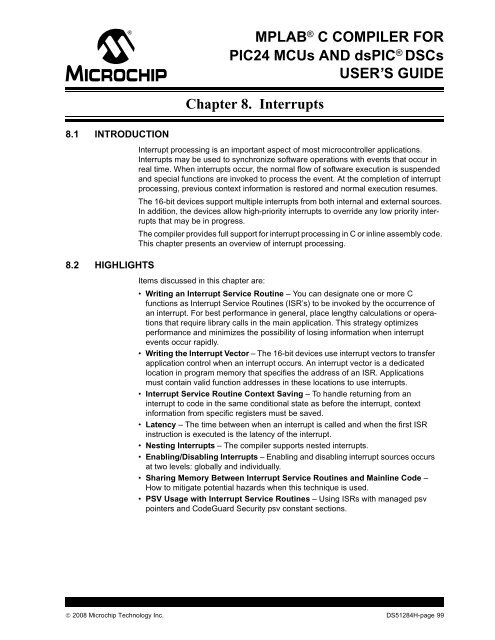MPLAB C Compiler for PIC24 MCUs and dsPIC DSCs ... - Microchip
MPLAB C Compiler for PIC24 MCUs and dsPIC DSCs ... - Microchip
MPLAB C Compiler for PIC24 MCUs and dsPIC DSCs ... - Microchip
You also want an ePaper? Increase the reach of your titles
YUMPU automatically turns print PDFs into web optimized ePapers that Google loves.
8.1 INTRODUCTION<br />
8.2 HIGHLIGHTS<br />
<strong>MPLAB</strong> ® C COMPILER FOR<br />
<strong>PIC24</strong> <strong>MCUs</strong> AND <strong>dsPIC</strong> ® <strong>DSCs</strong><br />
USER’S GUIDE<br />
Chapter 8. Interrupts<br />
Interrupt processing is an important aspect of most microcontroller applications.<br />
Interrupts may be used to synchronize software operations with events that occur in<br />
real time. When interrupts occur, the normal flow of software execution is suspended<br />
<strong>and</strong> special functions are invoked to process the event. At the completion of interrupt<br />
processing, previous context in<strong>for</strong>mation is restored <strong>and</strong> normal execution resumes.<br />
The 16-bit devices support multiple interrupts from both internal <strong>and</strong> external sources.<br />
In addition, the devices allow high-priority interrupts to override any low priority interrupts<br />
that may be in progress.<br />
The compiler provides full support <strong>for</strong> interrupt processing in C or inline assembly code.<br />
This chapter presents an overview of interrupt processing.<br />
Items discussed in this chapter are:<br />
• Writing an Interrupt Service Routine – You can designate one or more C<br />
functions as Interrupt Service Routines (ISR’s) to be invoked by the occurrence of<br />
an interrupt. For best per<strong>for</strong>mance in general, place lengthy calculations or operations<br />
that require library calls in the main application. This strategy optimizes<br />
per<strong>for</strong>mance <strong>and</strong> minimizes the possibility of losing in<strong>for</strong>mation when interrupt<br />
events occur rapidly.<br />
• Writing the Interrupt Vector – The 16-bit devices use interrupt vectors to transfer<br />
application control when an interrupt occurs. An interrupt vector is a dedicated<br />
location in program memory that specifies the address of an ISR. Applications<br />
must contain valid function addresses in these locations to use interrupts.<br />
• Interrupt Service Routine Context Saving – To h<strong>and</strong>le returning from an<br />
interrupt to code in the same conditional state as be<strong>for</strong>e the interrupt, context<br />
in<strong>for</strong>mation from specific registers must be saved.<br />
• Latency – The time between when an interrupt is called <strong>and</strong> when the first ISR<br />
instruction is executed is the latency of the interrupt.<br />
• Nesting Interrupts – The compiler supports nested interrupts.<br />
• Enabling/Disabling Interrupts – Enabling <strong>and</strong> disabling interrupt sources occurs<br />
at two levels: globally <strong>and</strong> individually.<br />
• Sharing Memory Between Interrupt Service Routines <strong>and</strong> Mainline Code –<br />
How to mitigate potential hazards when this technique is used.<br />
• PSV Usage with Interrupt Service Routines – Using ISRs with managed psv<br />
pointers <strong>and</strong> CodeGuard Security psv constant sections.<br />
© 2008 <strong>Microchip</strong> Technology Inc. DS51284H-page 99

















